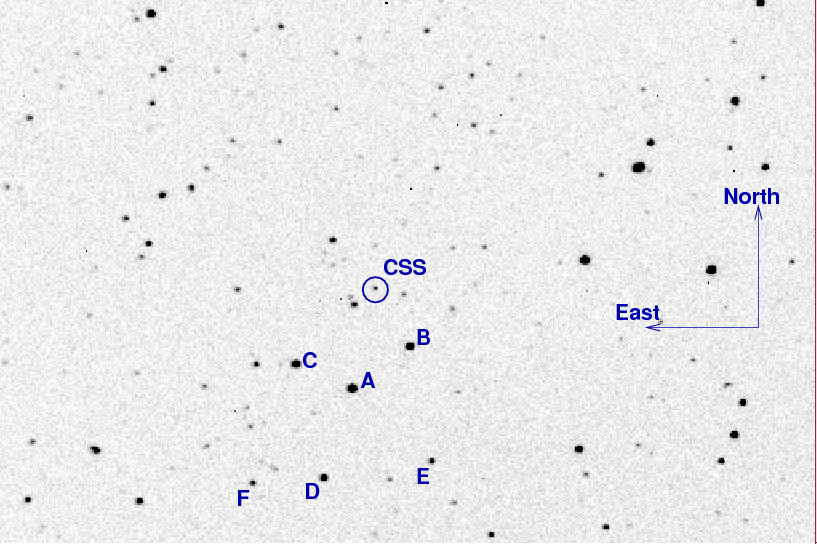
On the night of Aug 21/22, 2012, I observed the variable star CSS 203938-042908 , a cataclysmic variable star recently discovered by the Catalina Sky Survey.
The setup was:
Notes from the night
This is a chart of the field of CSS203938-042098, based on a 30-second exposure taken on Aug 19/20, 2012. The field of view is about 14 by 10 arcminutes.

The AAVSO provides magnitudes for a number of stars close to the variable star -- see their web site's Variable Star Plotter (VSP). I'll use the star marked "B" above to set the instrumental (unfiltered) magnitude scale to be approximately equal to "V". According to the AAVSO,
Label AUID RA Dec AAVSO B V ----------------------------------------------------------------------- B 000-BKQ-175 20:39:35.08 -4:30:16.3 131 13.692 13.072 -----------------------------------------------------------------------
The overall sensitivity of the unfiltered CCD, telescope, etc., is probably not too far from that of the V-band. I measured instrumental magnitudes for stars in each individual image using simple aperture photometry with a radius of 3.0 pixels = 5.8 arcseconds and sky defined by an annulus around each star. This small aperture produced the smoothest curve of the faint target star, but it also caused larger image-to-image adjustments than large apertures, due to the frequent trailed or asymmetric PSF (which had a size comparable to the aperture). Following the procedures outlined by Kent Honeycutt's article on inhomogeneous ensemble photometry, I used all stars available in each image to define a reference frame, and measured each star against this frame.
The difference between the mean instrumental magnitude of star B and the AAVSO V-band measurement was used to shift the instrumental magnitude scale to an approximation of the V-band scale -- but remember that the observations are unfiltered,
The night was a decent one, as this graph of the image-to-image zeropoint offset shows. A clear night should show a nearly horizontal line. Clouds appear as increases in the value of the zeropoint.
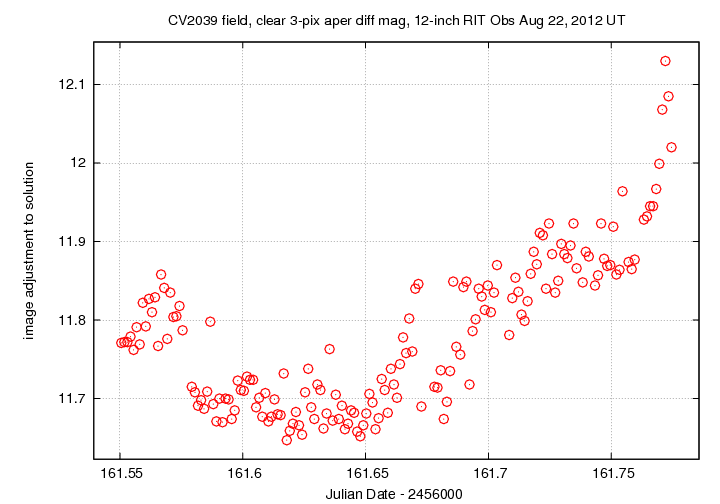
The scatter as a function of instrumental magnitude shows that the brightest unsaturated stars had a scatter of roughly 0.004 mag, while the target -- at instrumental mag 3.64 -- clearly varies significantly compared to other stars of similar brightness.
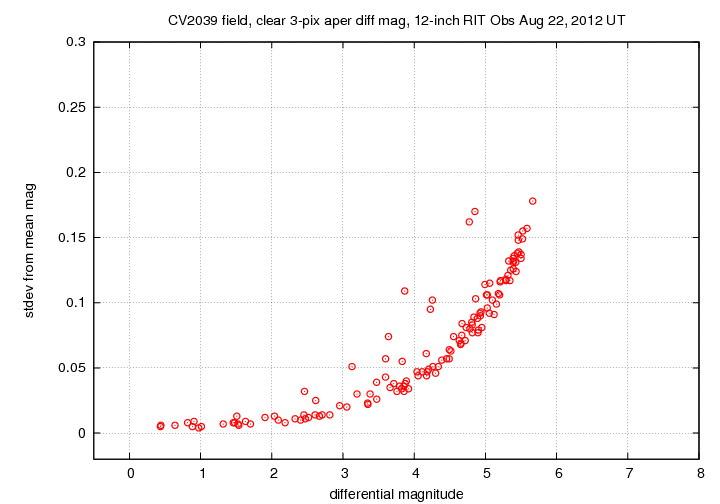
Here are light curves of the target star (green crosses) and some of the other stars in the field.
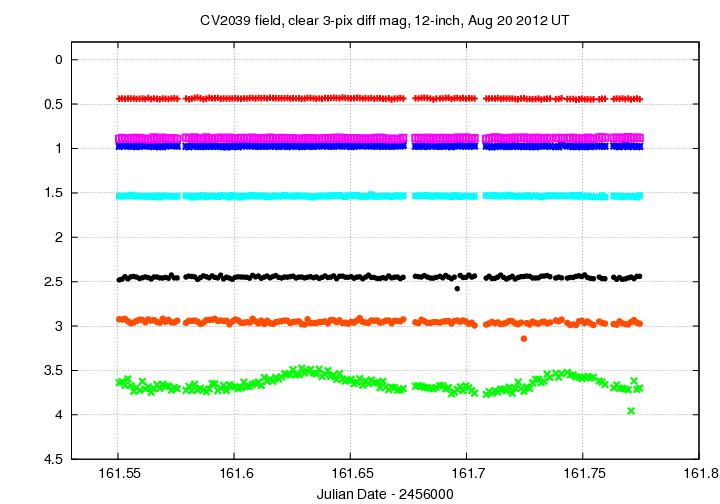
The target CSS203938-042908 goes through about two cycles during the observations. The scatter in the measurements, roughly 0.04 mag, is a bit smaller than it was with the 30-second exposures I used two nights ago.
I sent a message to cba-data with the following report. This shows only the first few lines of measurements -- the full set can be retrieved using the link below.
# Measurements of CSS203938-042908 made at RIT Obs, Aug 22, 2012 UT, # in fair conditions, # by Michael Richmond, using 12-inch Meade and SBIG ST-8E CCD. # Exposures 90 seconds long, no filter. # Tabulated times are midexposure (FITS header time - half exposure length) # and accurate only to +/- 1 second (??). # 'mag' is a differential magnitude based on ensemble photometry # using a circular aperture of radius 6.5 arcseconds. # which has been shifted so AUID 000-BKQ-175 has mag=13.072 # which is its V-band magnitude according to AAVSO. # # UT_day JD HJD mag uncert Aug22.05058 2456161.55058 2456161.55598 15.737 0.040 Aug22.05183 2456161.55183 2456161.55723 15.725 0.041 Aug22.05307 2456161.55307 2456161.55847 15.768 0.038
I have sent this data to the Center for Backyard Astrophysics and vsnet-campaign-dn@ooruri.kusastro.kyoto-u.ac.jp via E-mail.
Around 1 PM on August 22, 2012, Billy Vazquez (AST grad student) and I cleaned the front surface of the corrector lens of the 12-inch telescope. We acquired this telescope in June, 2003, and had not cleaned the front surface since then; so nine years' worth of dust, pollen and other stuff had built up to form a pretty nasty layer. Take a look at it in the "before" pose (at left) with the sunlight shining onto the surface.
Following the method described in Arkansas Sky Observatory's fine optics CLEANING SYSTEM: Part I , we gently brushed dust from the surface, then applied a liquid and wiped it clean. The result is shown on the right. It certainly looks cleaner, and I hope to quantify the increase in sensitivity on the next clear night.
Added Aug 24, 2012
Based on measurements of the field on Aug 21/22, 2012 (pre-cleaning)
and Aug 23/24, 2012 (post-cleaning),
it appears that the dust was blocking 3-4 percent
of the light entering the telescope.
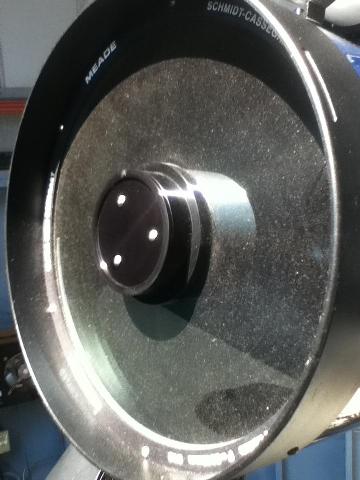
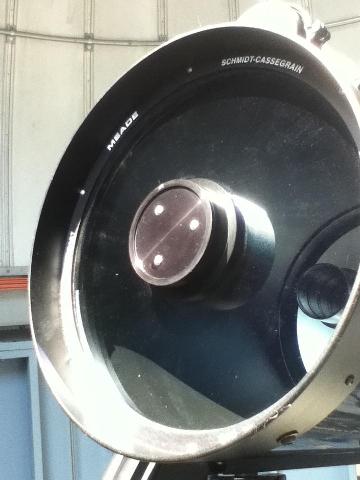
Last modified 08/22/2012 by MWR.